Book Reviews Shelf 2 - Technical and How-To
©opyright by James Ollinger. All rights reserved.
Contents:
|
Ansel Adams: The Camera, The Negative and The Print
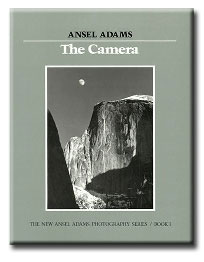 |
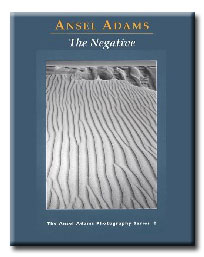 |
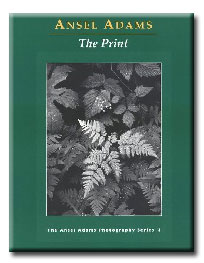 |
Back in the early 1950's, Ansel Adams wrote a six-volume series of small books on photography, The Camera, The Lens, The Negative, The Print, Artificial Light and Polaroid Photography. I tried them and didn't care for them: I found them dry and intimidating. Twenty years later he revised and combined the first two volumes as The Camera and Lens. I do not know whether he had a ghost writer, a better editor, or simply matured as a writer over the years, but it was a far more readable and interesting book. So I was highly encouraged when he again revised the whole series as a three volume set not long before his death in 1984. These three are the best yet. And while it would have been nice to read the master's updated opinions on artificial light and the latest brew from Polaroid, I felt lucky to get this at all.
The Camera, as its title suggests, covers camera equipment and technique; it is the weakest of the series because it is the most dated. The problem with each edition of Adams's technical books has been its survey of current equipment; the information becomes less relevant over time. Thus no mention of any facet of the digital revolution. No mention of the electronic powerhouse 35mm SLRs that dominated the late 1980s and 1990s, with their sophisticated auto-focus and complex through-the-lens metering capabilities. The information remains accurate but incomplete.
Even though the book is dated, the presentation is still top-notch. Adams was (or had great help) also an excellent writer. I found his explanations clear and concise. The book (as is the whole series) is well illustrated and beautifully presented.
The only thing I truly found lacking in the first book was an in-depth discussion of the art of photography, which is truly where Adams excelled. Chapters include technical topics such as "Small-Format Cameras," "Lenses," "Shutters," and "Meters and Accessories," but there is next to nothing about composition and image design.
The Negative serves as the introduction to Adams's famous Zone System and its application in creating images on negative film. Note that I said creating and not recording, as the essence of Adams's technique is in the manipulation of materials—camera, negative and print—to create the image one desires.
This volume suffers less from obsolescence than The Camera because the emphasis is more on the Zone System and applying it to the available materials rather than surveying the materials available at the time. He is also aided by the fact that general darkroom techniques and procedures have not changed greatly since the depression. Again, at the time that Adams wrote this there were no desktop photo scanners and no Adobe Photoshop; a quarter-century from now this book may be useful only as a guide to how things used to be done, when B&W films have gone the way of the daguerreotype, but for now the book is still highly relevant and useful. This is, in my opinion, the most valuable volume of the three.
The final volume in the series, The Print, falls somewhere between The Camera and The Negative in terms of aging. Like the others it is beautifully written and presented. Like The Negative it has a lot of valuable advice and information; but like The Camera it is tied more directly to then-current materials. But the wealth of technique more than makes up for this shortcoming.
Series Synopsis
Pros: Very well written and profusely illustrated.
Cons: Equipment and material-specific information is accurate but becoming obsolete.
Ansel Adams: Examples
Examples: The Making of 40 Photographs is not just an exhibition, but an explanation. As with his technical books,
Adams 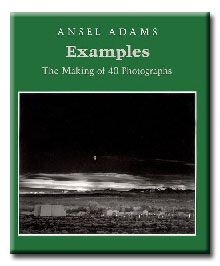 shows off his writing skills with some of the most engaging
technical commentary I've seen in a photo book. Rather than simply present raw data ("f16 at 1/50th with a K2, developed in ABC pyro and printed on
Azo Grade 3") or dry explanation, Adams's technical explanation sounds far more like a friendly conversation than a professorial lecture. For instance,
his commentary on the making of "The Golden Gate before the Bridge" doesn't end with his comments on trying to keep the camera still in the wind before
the cloud composition deteriorated: it includes asides on the state of his camera equipment at the time and the trials befalling photographers of an
earlier era. The result is a casualness that humanizes the man underneath the focusing cloth.
shows off his writing skills with some of the most engaging
technical commentary I've seen in a photo book. Rather than simply present raw data ("f16 at 1/50th with a K2, developed in ABC pyro and printed on
Azo Grade 3") or dry explanation, Adams's technical explanation sounds far more like a friendly conversation than a professorial lecture. For instance,
his commentary on the making of "The Golden Gate before the Bridge" doesn't end with his comments on trying to keep the camera still in the wind before
the cloud composition deteriorated: it includes asides on the state of his camera equipment at the time and the trials befalling photographers of an
earlier era. The result is a casualness that humanizes the man underneath the focusing cloth.
Granted, Adams doesn't get very deep into the mechanics of how he produced the prints. The book is more about the rationale of why he made the photo in the first place, or how he achieved an effect that he wanted. Anyone wanting a deeper discussion of tools and techniques should go The Negative and The Print instead.
Now if I ruled the world, these books would have been double their size—not in thickness, but in length and width. Adams's photographs are powerful, but physical size gives them even more power. If any book deserves a coffee-table edition, it is this one.
Synopsis
Pros: Beautiful reproductions of his best-known works.
Cons: Too small a format.
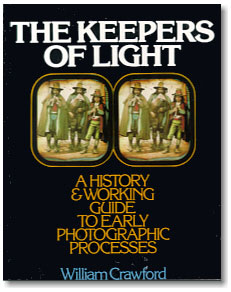 William Crawford: The Keepers of Light
William Crawford: The Keepers of Light
The silver-gelatin process that became the backbone of photography became dominant in the 20th century. Before that the art was very much in flux, with any number of competing processes that waxed and waned over time—Daguerreotypes, Cyanotypes, Ambrotypes, salted papers, gum dichromate, Van Dykes, platinum and palladium prints, collodion—to name a few. Most of these processes are long gone—practiced only by a very few artisans who keep the art alive.
The Keepers of Light is really two books in one. The first part is a wonderful history of photography during the first century of its development. It weaves two skeins in its narrative—the technical aspects, as we move from Daguerreotype to wet collodion to dry collodion, from salted papers to gravure to platinum emulsion; and the artistic aspects: the movement from portraitists to naturalists to pictorialists to Stieglitz and Strand. Any art is heavily influenced by its technical capabilities, be it music, imagery, or even dance, and photography is no exception. The photographs made by these early practitioners took their current technical capabilities and wrote (and rewrote) the rules of form. This is the first book I have seen that weaves these histories together so thoroughly.
The second half of the book is a tutorial of the techniques themselves. Thus one just doesn't read about photogravure as practiced by Karl Klic, there is a step-by-step section on how to perform it oneself. Be warned—these aren't easy and the results are definitely an acquired taste.
There are other books that teach these old processes. And each one may handle a specific topic better; but I believe that The Keepers of Light covers the field very well, and should be the first stop on an exploration of alternative processes.
Synopsis
Pros: The book on alternative processes. Great historical perspective as well.
Cons: I haven't found any yet.
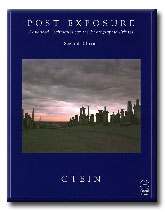 Ctein: Post Exposure
Ctein: Post Exposure
Please note that the thumbnail of the book cover is for the 2 nd edition—see note on this edition at the end of this review.
Ctein is probably most famous as a dye-transfer printer, which is a color technique that yields beautiful prints but requires a great deal of expertise. I know him as a magazine writer (from the dear-departed "Camera & Darkroom" and the more recent "Photo Techniques"); any time I see his name on the Contents, I know I'll be in for some kind of treat.
Most photography books are introductions or surveys—Post Exposure is Graduate School—serious students only. It's all about printing, both B&W and color (though color gets the lion's share), the articles dare to take the reader to another level of performance. Consider the topic, "Save a Tree: Learn to Print" about wasting test-prints, whether to filter variable-contrast papers above or below the lens, color film masking, and how to choose and test enlarging lenses. If you're comfortable in your darkroom, this is the next step.
But it's not for the faint of heart. Ctein is a pro and holds a higher standard than most; reading this book often makes me despair that everything I own is junk or hopelessly out of kilter. Two subjects in particular, one on enlarging lens misalignment and another on light-meter calibration make me wonder how I ever got anything done. On the other hand, Ctein offers methods for testing each. And this is just in the early stages of the book. Here's one that made my hair fall out in clumps—the very end of the book, "Choosing the Right Lighting for Viewing Prints"—aka if it's bright enough for you to see good shadow tone separation, you're killing your print.
Likewise, the book is technical. Beautifully printed and illustrated, but be ready for those H&D curves and lots of them. Plus test strips, tables, and data, data, data. But then, this is an advanced book. If you want something light, go read The Joy of Photography.
Synopsis
Pros: Great printing information you won't find anywhere else.
Cons: May make you want to junk everything you own.
Note on 2nd Edition: this is available as a free PDF download on Ctein's website. with the author's blessing. Go get it before he changes his mind.
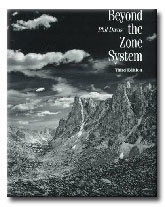 Phil Davis: Beyond the Zone System
Phil Davis: Beyond the Zone System
I hate the title of this book—it gives the impression that it should be read after mastering The Zone System, or that this is some alternative that frees us from the tyranny of it. Instead, this is the best (that I've read) book about learning The Zone System. But of course there are 500 other books with "Zone System" in the title—you gotta make yourself stand out somehow.
The late Phil Davis was highly regarded as one of the best teachers of the method, and this book is single-minded in that purpose. Ansel Adams's The Negative also walks the reader through The Zone System, but Beyond the Zone System is much more a text book. The subject is broken up into easily manageable bites which are then thoroughly discussed—and each chapter ends with a series of exercises to drill the lessons home. If you get through this book, you'll have the subject down cold.
The only real problem I have is that it's printed on regular paper, instead of the glossy, high-quality paper. It's fine for text and for charts and illustrations, but the photograph reproductions are beyond terrible. At least in The Negative or Post Exposure the reader can look hard at the examples and get a sense of the tonal separations discussed in the narrative (The Negative is particularly good about this). In this book—forget it. If you find yourself struggling to visualize the difference between Zones I, II and III or VII, VIII and IX, these photos probably won't help. If any book cried out for a section of high-quality "plates," this book is it.
Those murky photos aren't exactly inspiring either. I'm plotting curve after curve after curve so I can make that?
Still, I wouldn't trade the book for anything. Between this one and The Negative, the reader will be well schooled in the art and science of sensitometry.
Note: My copy is the 3rd edition. There's a 4th edition which I have not seen: I don't know if the photograph quality is any better in that edition.
Synopsis
Pros: About as lucid and thorough as you'll find.
Cons: Poor quality photo reproduction.
Jack Dunn and George Wakefield: Exposure Manual (3rd Edition)
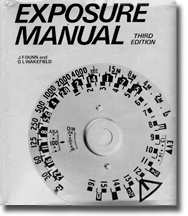 I purchased this off the internet thinking it was a companion to hand-held exposure meters and wanted it for my Light Meter collection. Had I known what it really was, I would have bought it decades ago.
I purchased this off the internet thinking it was a companion to hand-held exposure meters and wanted it for my Light Meter collection. Had I known what it really was, I would have bought it decades ago.
This is a series, in-depth discussion of photographic exposure. You might say that the subject is covered in other books—yes, but most books just cover the fundamentals. This is encyclopedic. They cover the role of exposure on film, how exposure relates to density, how film speeds and curves are measured, and so on. They discuss hand-held meters, both reflecting and incident, spot meters and TTL camera systems of the day.
This is the 3rd edition, published in 1974. The first is from 1952 and the second is 1958 and I haven't seen them so I can't compare. This version was co-written with Dr. George Wakefield (who wrote Exposure Control in Enlarging) and has been extensively modernized.
It's an impressive book: it's filled with charts, graphs, sample photographs and diagrams. The entire book is printed on high quality glossy paper so that the sample prints are clear and understandable; so many older books on photography are printed on inexpensive paper and the example prints look muddy and awful. Notes in the text and captions link everything together. This is a very well thought-out, presented book.
Large amounts of the book are obviously dated, but not quite obsolete. While the authors anchor much of their practical discussion using the materials of their times such as the Weston Euro-Master, the concepts are still valid; we still use reflected light, incident and spot readings today. We have more options and some are more complicated, but the basic concepts are still valid and, IMO, usually poorly explained and hazily understood.
I'd love to see this book revised and applied to DSLRs, because much of the information is still valid and applicable; and it seems like the amount of "serious" photographic infomation published declines each year, and serious students of photography are having to reinvent the wheel because the old knowledge is simply not being passed along.
Synopsis
Pros: Not for beginners, but a hell of a book on exposure's effects, its measurements and methods. Highly recommended.
Cons: Somewhat obsolete, but less than you might think.
Andreas Feininger: Successful Photography, Successful Color Photography and The Creative Photographer
Feininger's instructional books carry different titles depending on the publisher; in particular it appears that US and UK editions often have different, yet similar titles. Rather than really stoke the confusion, I'm giving the titles for the editions that I personally have—some US, some UK.
Andreas Feininger was quite a character. He was born in Paris, grew up and educated in Germany, but his parents were Americans of German ancestry. His father Lyonel was a famous artist and instructor.
Andreas studied architecture in Germany but couldn't find work in the gloomy (European) 20s. He eventually moved to Sweden where prospects were no better, but made a living as an architectural photographer. When World War II broke out and foreigners were not allowed to carry cameras for fear of espionage, he went to the United States. He joined the staff of the legendary Life magazine where he became one of their celebrity photographers for the next twenty years.
In addition to publishing collections of his work, he wrote books on instruction as well, and was a long-time columnist for Popular Photography. His technical books began with Feininger on Photography (1949) and Advanced Photography in 1952.
My books pick up after this point, when he wrote a trilogy called Successful Photography, Successful Color Photography and The Creative Photographer. The first of the series was a book about technique and skewed toward B&W. The second was the same but dealt with color. The last was a book about the art of photography, the hows and whys: what makes a photo, what makes a good photo, what makes an exceptional one. It was not a book about technique—it was about photography independent of the equipment used to make the image.
Feininger's books were excellent texts on technology and technique, though they had the problem of all how-to texts in becoming obsolete as time passed. He tried to not to tie himself down to specific makes, models and brands, which gave his books longer lives but they still became dated. Still, they offer a lot of useful information even today because a lot of the basic information—how exposure works, the behavior of lenses, color theory, etc., doesn't change. Those of us who still shoot film still use filters. Those of us who shoot digital still use filters, or use an in-camera equivalent, for various effects. Feininger's explanations still hold.
The books are dry and not as heavily illustrated as modern volumes, which makes less lively and colorful. Feininger's writing is very straightfoward and impersonal. I think they're better than Ansel Adams's series from the mid-50s, largely because Adams mostly wrote about equipment and practices, but very little about art. Feininger, particularly in the The Creative Photographer, tackles the subject of what makes great images, what makes great prints, and so on.
Feininger's books sold very well, and they're still found on library shelves and often at used bookstores. The titles are often similar enough that it's difficult to tell them apart—when I see them at used bookstores for sale I still struggle to remember which I have and which ones I'm missing. But while they're very dated, I think they're worth a read (especially if you can get one from a library for free). There's a lot of gold still in these rivers.
Andreas Feininger: The Complete Photographer and The Complete Color Photographer
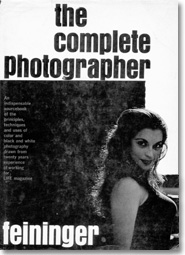 Feininger began the The Creative Photographer with this comment:
Feininger began the The Creative Photographer with this comment:
This is a summing up. It is the last book on photographic topics that the author intends to write. From now on, whatever he has to say, he will say with his photographs.
Obviously that wasn't the case. He wrote columns for Popular Photography and Modern Photography for decades, he tweaked his books with subsequent editions, and about 10 years after his Successful Photography came out, he began a full revision which he named The Complete Photographer.
I don't know who came up with the titles, but I've always found them confusing. It's always been difficult for me to remember which ones I have and which I do not. Luckily the books were big sellers and now are inexpensive on the used market, so I don't have to risk a lot of money if I buy something I already have.
The The Complete Photographer supersedes The Creative Photographer, and to a lesser extent the other two books in that trilogy. The Complete Photographer talks about the state of the art as it was in the mid-1960s, and includes a shorter (but still interesting) section on the art of photography. Again Feininger tries to discuss the nuts and bolts without tying himself too much to specific equipment which will become obsolete, and with about the same success as before. Many subjects, like exposure, are still valid. Many things, like flash photography, were quickly antiquated (it's amazing to see the speed of fundamental change from early flash bulbs to later flash bulbs, mini-bulbs, cubes, and electronic strobes. Things didn't stabilize again until the 70s when electronic flash really took over).
It's with this series that Feininger introduces a new feature, cross-referencing. The margin of the text included page numbers for topics that were defined or mentioned elsewhere. So on page 102 he mentions fish-eye lenses, with a cross-reference in the margin to page 343; on page 343 there's a much longer discussion on fish-eye lenses.
In 1969 he released The Complete Color Photographer, though I have a British edition; it appears that in the US and elsewhere it may have been Basic Color Photography or The Color Photo Book (as it refers to itself in its own notes on page 1!). Oy vey. Regardless, this book was, by Feininger's own design, a rewrite and replacement for Successful Color Photography, The Creative Photographer and The Complete Photographer, but with an emphasis on color work, not B&W.
The Complete Color Photographer reads very much like The Complete Photographer, except that the color editon is about three times as thick. Like The Complete Photographer it has cross-referencing in the margins, and it has sections dealing on the art of photography, not just the craft.
How does it compare with Ansel Adams's series? I think they're better than the ones from the 1950s. I think the Adams books in the early 1980s are better for technique and equipment, but they lack the discussion of art and style that Feininger liked to include.
If you want only one of Feininger's instructional books, I suggest this one (at least from among the ones I've read). It's the latest of the series so it's the least obsolete, it has a wealth of information that is still current, and it's encyclopedic in its scope and presentation.
Synopsis
Pros: Encyclopedic, thorough; covers areas (e.g why a photograph succeeds or fails) that most other books neglect; very inexpensive on the used market
Cons: Much of the technical info is obsolete; dry and under-illustrated by modern standards
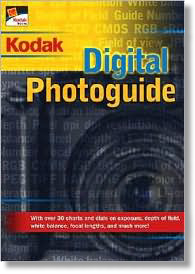 Michael Guncheon: Kodak Digital Photoguide
Michael Guncheon: Kodak Digital Photoguide
From the 1950s through the 1980s, Kodak sold a number of highly regarded technical books that they called "photoguides." They were notebooks: collections of data and tools to help photographers on a variety of levels. They had a small Masterguide, which had information of exposure, filters, flash. Their Darkroom Dataguides dealt with printing and processing. The Professional Photoguide was the Masterguide for advanced work.
They all pretty much disappeared, but in 2006 they brought this out, the masterguide for the 21st century. As with its predecessors, it is spiral bound to lay flat while open, its pages are heavy card, sections are tabbed and color coded, and there is a wealth of data and old-fashioned dial calculators for solving the problems your camera can't do itself.
It's not really a text book, it's a very boiled-down summary of information meant to be fast and helpful rather than encyclopedic. Many of the sections, like the one on Sensors, are interesting but are meant simply as a quick introduction or memory-jogger. The real value, in my opinion, is in the charts and calculators.
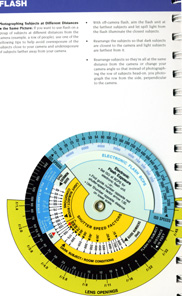
The Flash section is a typical example of what you get: It begins with a quick explanation of Guide Numbers (GN) and how to use them, and follows with a little table on how to adjust GN for different ISO speeds. After that there are suggestions for correcting flash exposure for different room and subject conditions and how to deal with subjects that are different distances from the flash. There's also information on using bounce, umbrellas, close-up and fill. And there's a dial calculator (see image at left) to solve various problems.
The dial calculator illustrates what's both excellent and lacking in this book. The calculator solves a variety of problems, but the markings are small (particularly in the fill-flash section)--I'm at a point in my life where I find this stuff very difficult to read in anything other than full sunlight. It would have been nice if it had been a little bit larger.
Also they really needed a section of instructions on how to use the calculator. A great example is at the very top: set ISO at BCPS for electronic flash unit. Know what BCPS? I didn't--it's not mentioned in the Digiguide; I had to look it up in a photo encyclopedia. (Beam Candle Power Seconds.) Most of the rest you can noodle through if you take the time and you can actually read the scales.
In fairness, the other calculators aren't so bad, though they may be more complicated (like the one for close-up exposure, p.52). The regular text print is small but still legible, and allowed them to keep the physical size of the book down so it's more likely to fit in a camera bag.
Other than the flash calculator's readability, my only disappointment is that they left out a copy of a gray card, which was a mainstay in earlier photoguides. I keep my Color Darkroom Dataguide in my camera bag simply for the gray card and gray-scale/color scale pages it included. I was hoping this would have the same.
As mentioned before, this is not a textbook or an introductory guide, it's really a notebook of information meant to help solve problems or quickly answer questions (BCPS aside) without going into a lot of detail. For what it is, I think it's great and well worth the less than $20 cost. Considering the price of many photo books is over $35, it's a bargain.
Synopsis
Pros: A great guidebook of data and calculators for solving problems; will fit in many camera bags
Cons: some of the calculators are too small and hard to read, overly complicated and under-explained
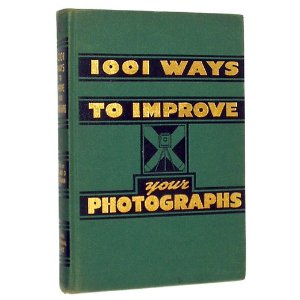 Willard D. Morgan (ed.): 1001 Ways to Improve Your Photographs
Willard D. Morgan (ed.): 1001 Ways to Improve Your Photographs
I believe this book was offered as a freebie or very cheap as the introduction to a book club, which is why it's so commonly found at used bookstores these days. This was printed in 1945 so it's very dated.
The book is really like several issues of general-interest photo magazines of the era all bound together. It's a collection of articles on various subjects, from simple portrature to special light sources, black and white and color, from how to build a darkroom to photographing movie stunts. There are photogravure along with how-tos, so few stones are left unturned.
It's largely of interest now only to those of us who are interested in photo history and techniques. Some sections, such as those on lighting, never change, but modern readers will likely find the writing (and the photo reproductions) flat and uninspiring.
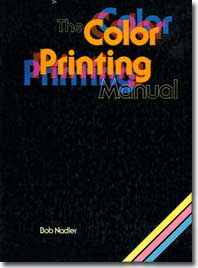 Bob Nadler: Color Printing Manual
Bob Nadler: Color Printing Manual
I was lucky enough to find this back when I wanted to do color darkroom work. It's an excellent introduction into both the theory and practice of creating color photos. The first chapter is the most useful now because it's the least obsolete: a discussion of additive and subtractive color systems, how color films and papers work, how negatives and reversals (direct positive) systems work. Subject chapters deal with equipment, materials and how to get it done.
Color darkroom work has mostly been killed off by Photoshop, but if you still want to try your hand, this is a valuable book all the way through. Even though some of the papers and chemistry are no longer used, the heavy equipment (enlargers, color analyzers, drums and trays) are still available and perfectly good. The concepts of color filtration packs, how to make print, how to correct, are still applicable. The book is particularly rich in its survey of equipment and how to use it.
It's also got an interesting hodge-podge of equipment data that usually doesn't show up in other books of this type. The section on color analyzers not only discusses then-current machines like Omega's Simtron II and Chromegatron, but includes an exploded parts diagram and an electrical schematic for each. There are manufacturer's specs for a number of enlargers, including Beselers, Dursts and Omegas, and a survey of the color analyzers of the time--not just the Beseler PMs and the Omegas, but Corsar Mornicks, EPOIs and Minolta's analyzer show up as well.
It's well illustrated, clean, bright and colorful and well put-together. It's also over 30 years old (as I type this) and last time I checked the on-line bookstores, good copies were selliing for under $10. I think that's a bargain.
Synopsis
Pros: Very good introduction to how color works. Very good eference for equipment that is still available.
Cons: Mostly obsolete, particularly when discussing materials and chemistry that are no longer produced.
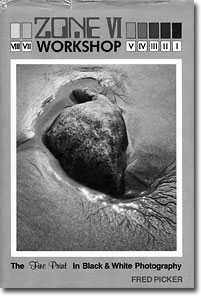 Fred Picker : Zone VI Workshop
Fred Picker : Zone VI Workshop
Fred Picker is almost completely forgotten now, but for awhile he was one of the most controversial and opinionated men in fine-art photography. It used to be a hoot to read the magazines after one of his articles would appear, because the letters-to-the-editor columns would froth for months afterward.
Picker was a fine-art photographer and a disciple of the Zone System; so much so that he named his outfitting company Zone VI Labs. They sold photographic equipment that was tailored to the needs of fine-art photographers, in particular cold-light enlarging heads and modified exposure meters that calculated in zones.
One of the problems with the Zone System is that it's often poorly explained, it looks overly complicated, and is so often wrapped up in art ideology that it feels like one is being indoctrinated into the mysteries of a secret society from which there's no turning back.
This book was Picker's attempt to explain the Zone System in a way that was easily understood and accessible, without all the f/64-crowd rigamarole that normally accompanies it. The book is slim and a quick read, and it's written in a terse, no-nonsense style. It takes you through exposure, development and printing in short, practical steps. It doesn't really get into athestics at all. It's only about technique. If you want Picker's infamous opinions about art, you need to look elsewhere.
The latter half the book is largely a catalog of Zone VI products. On the surface it seems like just a glorified advertisement, but this was very common practice. I have a number of books that are discuss equipment and technique, but are really just showcases for selling a line of product. Kodak sold tons of books, pamphlets, and newsletters on photographic art and technique using Kodak products. The problem with all of these is that they become obsolete as equipment is dicontinued; Zone VI was absorbed by Calumet many years ago, and their equipment now exists mainly on eBay and camera stores' Used inventory.
Likewise, the first section is rapidly going away as B&W film disappears. Yet the Zone System is, and still can be, useful, and Ithink this book is an interesting and readable introduction to it. Ansel Adams's later The Negative and The Print books are better written and more profusely illustrated; Phil Davis's Beyond the Zone System is more thorough and exhaustive, but this is still quick and easy.
Synopsis
Pros: Fast and very readable introduction to The Zone System without all the crap.
Cons: Most of the equipment is obsolete; you need to read it for the concept instead of practical application.
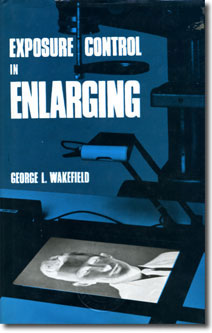 George Wakefield : Exposure Control in Enlarging
George Wakefield : Exposure Control in Enlarging
Over the years I've seen a great deal in print about exposure, development and handling of film, but relatively little about paper. Amateurs (and professionals who don't have to produce large volumes) tend to work by trial and error: making test prints and tweaking the exposure until it's right. Because B&W paper tends to process quickly, it's easy to work that way. It wasn't until color printing became widely popular, which is much more time consuming and expensive, that people seriously invested in darkroom meters.
This book from 1972 deals with metering systems for darkroom work in both the B&W and color lab. It discusses things I've seen only lightly touched upon (if at all—the use of light meters to determine print exposure; different methods; the relative advantage of one method over another; and a short description of commercially available meters and discussion on how to build them from scratch.
It's interesting stuff, though very dry. There are numerous characteristic curve charts, and various ways to measuring the curves. Dr. Wakefield discusses the relative values of Dmin, Dmax, ΔD, D-bar and ΔD-bar, in what sometimes becomes a sea of Ds. Ultimately it makes sense, but I found it took a couple readings to get it straight and several more to keep it straight. It's work, but if you are following along with what he's trying to explain, it is worth the effort.
A significant portion of the book deals with meters and metering systems. As Dr. Wakefield is English, the book describes a series a meters I'd never heard of: the Corfield Lumimeter, a Melico, a Philips PDT, the Revomatic (shown on the cover). I'm surprised that the Atlantic seriously separated the US from Britain in terms of darkroom electronics, I'd heard of none of these, and Wakefield made no mention of long-lived American classics like the Haynes photo-meter, the Spot-o-Matic, the Photoval, Colorval, or the Gossen Labosix. It makes me thing that they were simply unavailble, or so rare in England that he thought it worthless to even mention them in passing.
The plans are interesting. As the book deals with both spot and integrating/averaging metering systems, he offers plans for both types. The simplest is little more than a CdS cell directly hooked to an ohmmeter, and the user must translate the resistance into a useful light value (or create a custom meter face for direct reading). There is also a more elaborate machine, plus a vertical integrated job that uses a standard Weston Master exposure meter as its brain. Interesting stuff, but CdS technology has since been (happily) replaced by silicon blue sensors; something that occurred after the book's publication, so there's no mention of how to deal with them.
If you strip out the practical applications, there's still enough theory in the book to make an interesting, if dry, read. It discusses the ups and downs of measuring a spot vs. integrating and averaging; and if you're going to measure a spot, then the advantages and disadvantages of which values to read. It's a subject I've seen rarely discussed at all and never in depth.
Synopsis
Pros: Information on a subject I rarely see discussed anywhere else. The theory portions are useful if you're still doing darkroom work and want to understand how to properly use a darkroom photometer.
Cons: Mostly obsolete, though the theories can still be applied to modern materials and equipment if you want to make the effort.
Previous shelf: Cameras, Collecting, History
Next shelf: Portfolios and Photograph Collections
Return to Book Reviews directory
©opyright by James Ollinger All rights reserved.